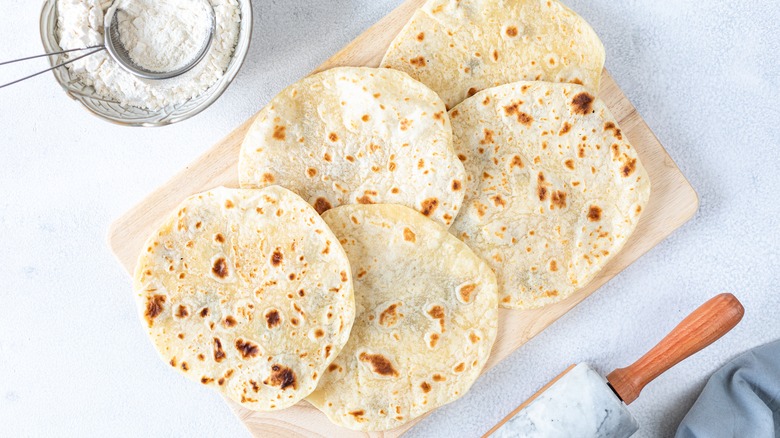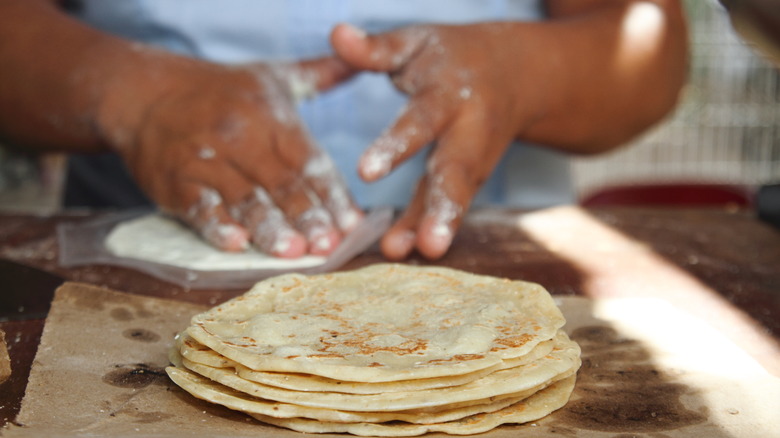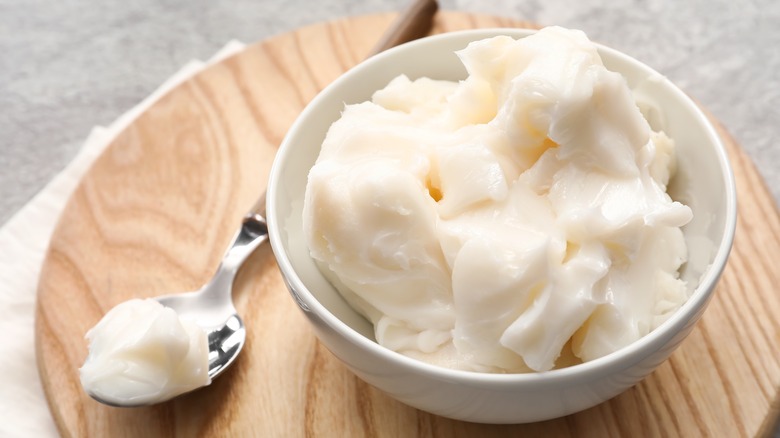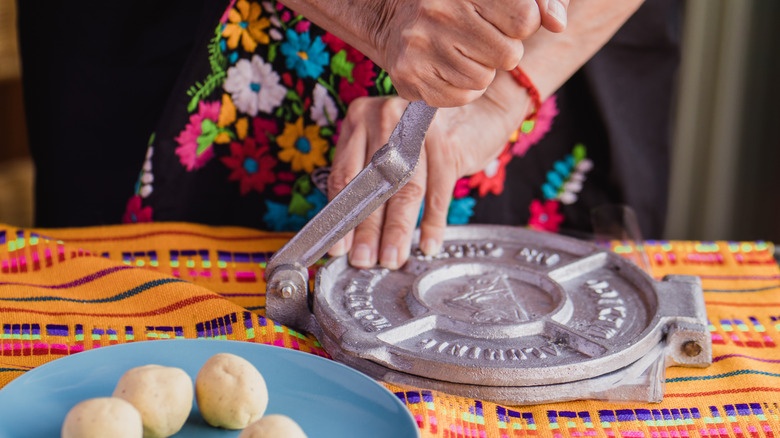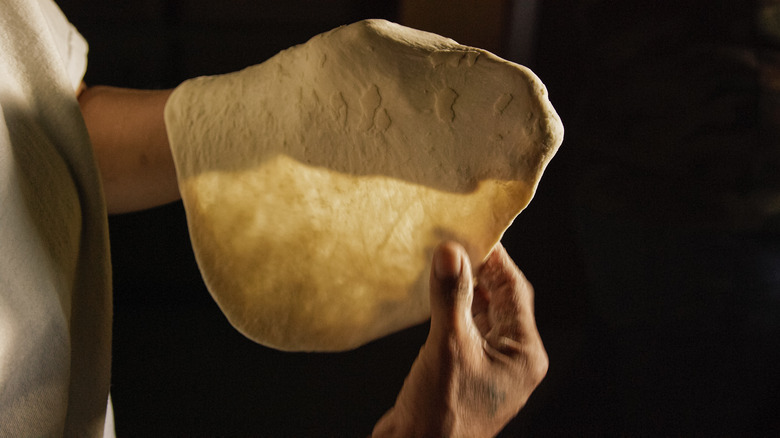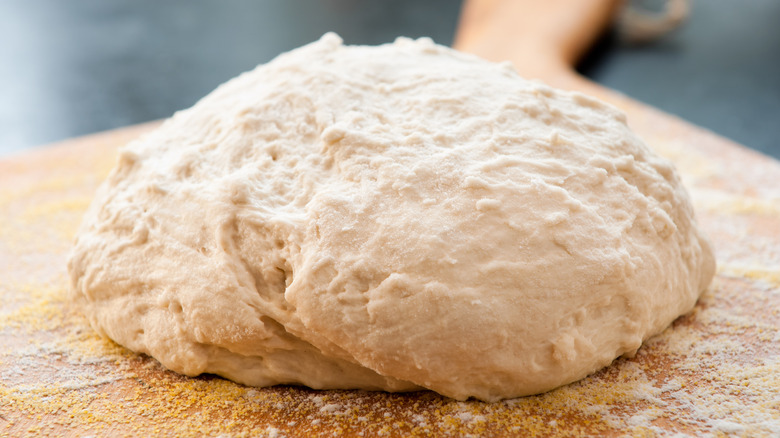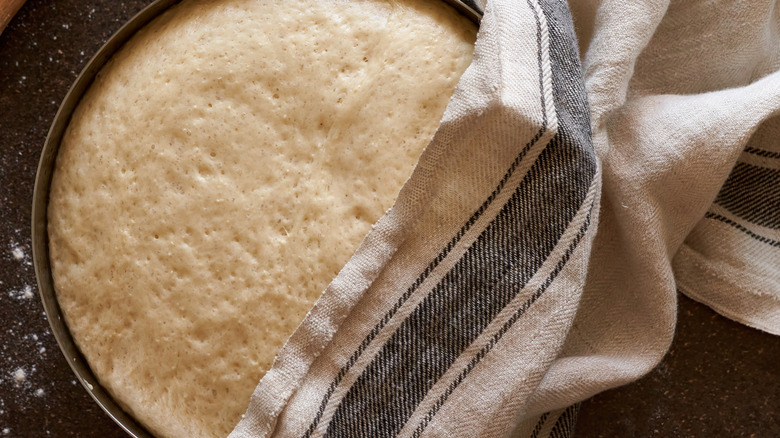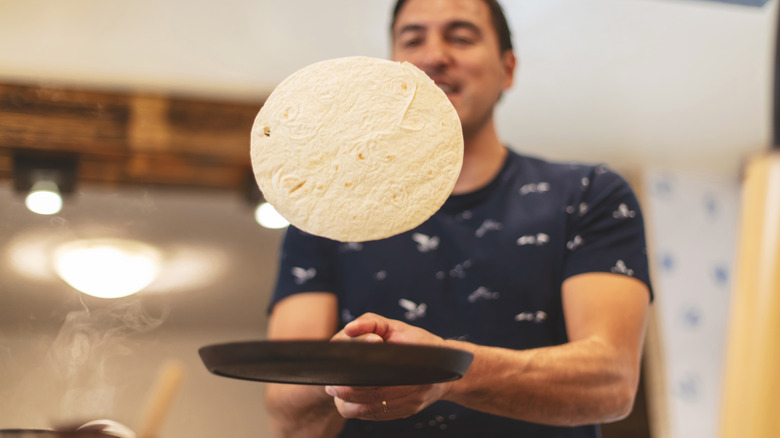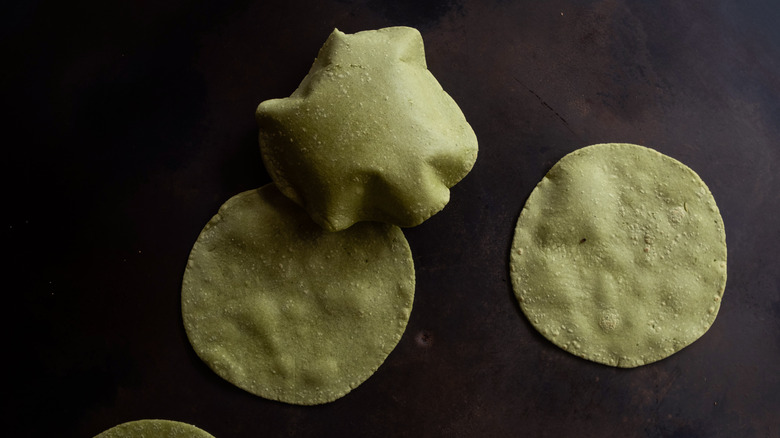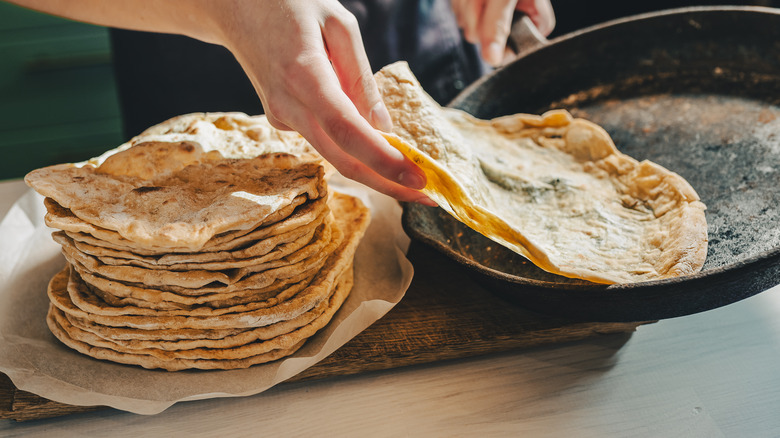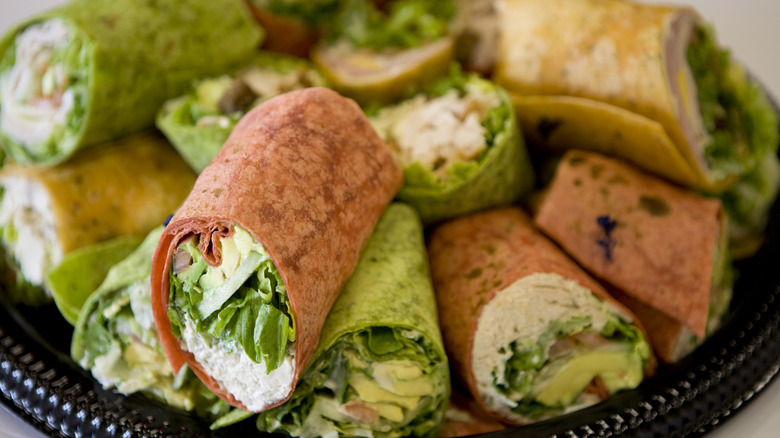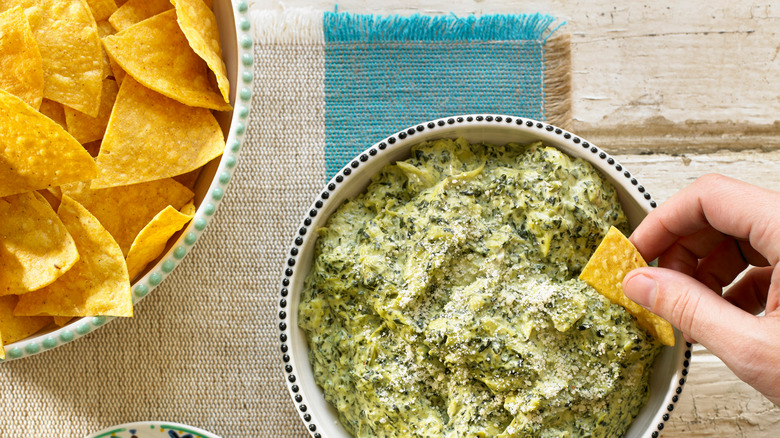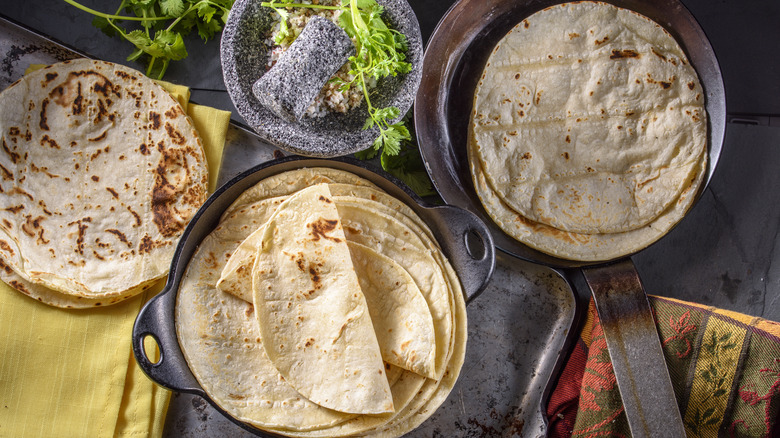12 Tips For Making The Best Homemade Tortillas
Choosing which carbohydrate we love most can be a difficult task. But if we absolutely had to rank them, tortillas would be near the top of the list. These flexible flatbreads are part of many Mexican and Central American dishes. They serve as the perfect vehicle for meats, vegetables, beans, and other toppings.
The two fundamental types of tortillas (corn and flour) are made similarly, despite starting with different ingredients. Corn tortillas are made using a type of corn flour known as masa harina. Flour tortillas are made from regular flour. But while making these flatbreads might seem intimidating to some, you might be surprised by how easy they are to rustle up. Homemade tortillas, like most homemade foods, are not just more unique and better-tasting than store-bought ones. With homemade tortillas, you also get that warm, satisfying feeling of having made something from scratch.
If you want to get your homemade tortillas just right, you'll need a bit of help. That's where we come in. We've put together our top tips for making the best homemade tortillas so that you can get them right the first time, and every time after that. Grab your masa and your tortilla press, and let's jump straight in.
1. Start with the best ingredients possible
High-quality ingredients are essential to making tortillas. You can have a tortilla technique that impresses even the most seasoned chefs. But as a recipe that's made with only a few ingredients, you better make sure those ingredients are good.
The main ingredient that you need to nail is your flour. Crucially, what type of flour you pick will dictate the style of tortilla you end up with. It's probably no surprise to hear that flour tortillas are made with flour. But more specifically, they are made with the all-purpose variety — which has slightly less gluten and protein than bread flour. All-purpose flours may be versatile, but they're not all made the same way. They can differ in protein content and in whether they're bleached or unbleached. For tortillas, you'll want to go for high-quality, unbleached flour with medium-high protein content. This allows the tortillas to stretch out and retain shape at the same time.
Corn tortillas are a slightly different story. For corn tortillas, a type of corn flour called masa harina is commonly used. Luckily, masa harina can be bought in stores, which saves you some of the work of the traditional style of tortilla making. Look for a masa harina that's made by a well-known brand. For tortillas, you can't go wrong with the masa harina made by Maseca, which is well-known for its quality.
2. For flour tortillas, your fat choice is essential
In a pinch, flour tortillas can be made with little more than flour, salt, and water. But if you want your homemade flour tortillas to go to the next level, adding fat is essential. Fat gives your tortillas extra flexibility and makes the dough more workable, which is helpful when trying to press it down to its ultra-thin shape.
However, although you can use a range of fats in flour tortillas, by picking the right one you'll get the best result. To keep things in line with tradition, and to amp up the flavor of your flatbreads, pork lard is the preferred choice. "Spaniards introduced pork to Mexico and we quickly took to it, using all parts of the animal. Lard really became the fat of choice because it was readily available and it has a strong flavor," Danny Mena, a chef that uses pork lard in his tortillas at Brooklyn's La Loncheria, told Epicurious.
If you don't have pork lard on hand, or you're catering for vegetarians, vegetable shortening is also a good choice, Mena says. The main advantage of shortening or lard is their solidity at room temperature. This means that they won't thin out your dough like vegetable oil or butter would.
3. Get a tortilla press
While you might be a fan of a more freewheeling shape for your tortillas, let's be honest: There's something deeply pleasing about a perfectly round flatbread. To achieve this, a tortilla press is a smart investment, especially if you're planning on making homemade tortillas more than once. Tortilla presses do the hard work for you. They effectively press your tortilla down to the right thinness and shape in one move, saving you time and energy, and allowing you to make batches quickly.
If you don't have a tortilla press, though, don't panic, as you can still make tortillas without one. You just need something that can press the dough as effectively. A heavy, flat-bottomed Dutch oven or skillet is best, as they give you the weight and surface area needed to get the dough balls down to their flat, round shape.
Whether you're using a tortilla press or a pan, it's highly advisable to put something both underneath and on top of the dough to stop it from sticking. Try and use a fairly thick, yet flexible piece of plastic, like a large Ziploc bag. Although plastic wrap can be used, it's usually way too thin.
4. Learn to recognize the best dough consistency
Without good dough, you're never going to make good tortillas. To produce the best flatbreads, learning what your dough should look and feel like is a vital step. With flour tortillas, you want things to be a little tacky, according to chef Danny Mena told Epicurious. "If you're working it in with your hands, it should feel almost too sticky — almost uncomfortable." While there is a temptation to work the dough well, when it comes to tortillas, Mena suggests only handling it until everything is just combined. If you overwork it, you end up with something slightly chewier, like pizza dough.
The order that you mix your ingredients can also affect the dough texture. Mena states that the dry ingredients are first mixed with solid fats. Once you have a mealy consistency, hot water is added. For corn tortillas, it's worth pointing out that things should be slightly less sticky. After you mix your masa harina and water, you should end up with a result that feels like cookie dough. Make sure it's not too tough, though. If it is, you can add a little extra water to loosen it up.
5. Don't make them too dry
One of the cardinal sins when it comes to making tortillas is a too-dry dough. In your zeal to make a dough that feels robust and solid, you might end up skimping on the water. This is a one-way street to cracked, crusty tortillas that snap when you try and fold them.
Dryness can be a particular problem with corn tortillas, which can become grainy and brittle when they're under-hydrated. That's why a key masa technique is to get the water ratios just right. You'll usually need around two-thirds of a cup of water for each full cup of masa harina you're using.
Texture-wise, you're looking for a smooth ball of dough — when it's all come together and allowed to rest. If, when handling it, it's becoming cracked and crumbly, it's a surefire sign that you haven't hydrated the masa enough, and your tortillas will fall apart fast in the pan. Bear in mind, too, that the level of moisture in the air can also have a big impact on how your dough hydrates. In less humid environments, the dough can dry out faster, with the surface losing moisture and cracking quicker than you might think. You may need to compensate for this by adding a little more water into the fray.
6. Let your dough rest
We hereby give you permission to put that dough down, turn on the television, and kick your feet up. Just like yourself at the end of a long day, your tortilla dough needs time to rest if it's gonna be its best self. Learning how your dough rests best will help you produce enviable flatbreads.
Flour tortillas need at least an hour to rest before they're ready to roll, chef and cookbook author Danny Mena told Epicurious. This isn't for any rising reasons, as might be the case with yeast-containing bread. Instead, tortilla dough needs to rest as it allows the flour and water to fully come together. If you're making flour tortillas in advance, you can always allow them to rest in the fridge, which slows down the hydration process, but makes them last longer. Mena allows his tortillas to rest for several hours in the fridge, before letting them return to room temperature for the rest of preparation.
Corn tortillas also need to rest, but potentially not as long as flour ones. After bringing the dough together, it needs roughly 15 minutes, or slightly longer, to rest before pressing. As with flour tortillas, this lets the dough hydrate properly, meaning it's easier to work with and won't crack.
7. Test your tortillas before cooking the full batch
When that urge for tortillas strikes, you don't want to do anything that'll prolong the process. But one key tip will help ensure that your tortilla batch is perfect, and will stop you from throwing them all out and starting again.
All it takes is a simple test tortilla. Before you cut your dough into separate pieces, ready to press and cook, cut off an amount that's enough for just one tortilla, and press that one. Then, assess how it looks. If the tortilla is cracking at the edges or looks dry and crumbly, your dough likely needs more water. On the other hand, if it looks sticky and overly soft, you might need to add more masa harina or flour.
This test can be done with both flour and corn tortillas, and it's a real time-saver. This allows you to adjust the ingredients as necessary, adding more water or dry ingredients. Once you've done that, do another quick test tortilla if you wish. Then, when you're happy, cook to your heart's content.
8. When cooking, look for the puff
One of the key signs of a well-made tortilla is the puff. That is when your tortilla is cooking in the pan, and suddenly, it starts to inflate and puff up like a beautiful, bready balloon. Your tortillas puffing up aerates them, making the resulting flatbread light to eat, instead of dense and tough.
But getting your flour and corn tortillas to puff up is harder than it looks. With flour tortillas, a successful puff occurs when you get a few elements just right. The first is the fat levels in the dough. You'll want to make sure you have enough fat, but not too much. It's also crucial to make sure that your pan isn't too cold, as this won't give the tortilla enough heat to generate the steam it needs to inflate.
The puff is also vital for corn tortillas, says food television celebrity and chef Pati Jinich tells King Arthur Baking: "A great tortilla will puff up like pita bread on the third flip and will be malleable, and not crack, when you fold it." Making sure your corn tortillas are really flat before cooking can help. To assist them in generating steam, it can also be useful to lightly press on them when they're in the pan with a spatula.
9. Don't overcook your tortillas
You've perfected your dough, you've let it rest for just the right amount of time, and you've pressed them into perfectly-round pieces. All that's left is to cook them. Simple, right? Well, cooking your tortillas is crunch time, and you might end up with a bit too much crunch if you get things wrong.
Overcooking tortillas can happen super quickly, due to their thinness. With both flour and corn tortillas, when they cook for just a touch too long, they can become brittle and crisp. This is a world away from the ideal tortilla consistency: soft flatbreads that wrap easily around your fillings.
When making homemade tortillas, keep a close eye on them, to ensure they're not burning or toasting. Aim for medium-high heat for your pan, and cook them for around 45 seconds to a minute on each side. If you trust yourself to flip them like a pancake pro, then go for it. But it's also a good idea to flip them using a spatula or tongs. Tongs have a particular advantage as when flipping them, you can also test their flexibility. The ideal tortilla is lightly blistered on its outside, and still soft on its inside. It's also a good idea to keep them in foil once taking them off the stove, so they remain warm and pillowy until ready to eat.
10. Add some flavorings for unique tortillas
Corn and flour tortillas, in our opinion, are the ultimate flavor containers. The relatively neutral, gentle taste of these carbohydrates allows the spicy fillings you put inside them to sing at top volume. But if you want these edible plates to have a little more life of their own, one top tip for making them more exciting is to add some flavorings directly into the dough. Getting creative with your homemade tortillas by adding fresh herbs, spices, or other seasonings can give them flavors that complement your chosen fillings, and also give the bread additional visual appeal.
For tortillas that are part of a Mexican menu, mixing cilantro into the dough brings a key taste of that cuisine front and center. Other herbs, like parsley or oregano, can add a herbal, floral effect. If you're looking for something a little spicier, try mixing cayenne or chipotle powder into the dough, or a few dashes of smoked hot paprika. Not only does this add extra heat, but it will also give your flatbreads a vibrant red tinge. If it's a hit of garlic you're after, rolling some minced garlic or garlic powder into the dough provides your tortillas with a pop of intense flavor that makes everything taste that much better. The world is your oyster when it comes to tortilla additions. In a way, you are only limited by your imagination.
11. Don't waste your leftover dough
Making bread is all about balance. It's also very easy to tip the scales in terms of quantities. What people often find in their excitement to make tortillas, they end up with too much dough for their purposes. Alternatively, a batch of dough that's slightly miss-made, particularly by oversalting, can end up in the trash, wasting time and money.
But instead of throwing out the leftover dough, put it to good use. Over-salted tortilla dough is particularly useful if you're planning on making tortilla chips, say commenters via Reddit. By turning the dough into shards of fried tortilla, you get to still make some delicious food out of it, and you also save on having to salt them once they're out of the fryer. Alternatively, slice the dough into strips or pieces using a pizza cutter, and drop them directly into hot oil, to then use in tortilla soup, or as a topping for soups or stews.
If your dough isn't over-salted — and you simply have too much of it — we'd recommend cooking up an additional batch of tortillas and using them in a different recipe. Taco pie casserole is a great way to make a fun, lasagne-style dish that uses up leftover tortillas. You can also mold them into muffin tins and bake them, to make casings for on-the-go tacos.
12. Once they're cooked, store them properly
Hopefully, at the end of it all, you've made a perfect batch of tortillas, and you're the talk of the town. But if you don't store them right, you'll find that those fluffy pieces of flatbread get hard and brittle, fast. Tortillas have a habit of drying out quickly, especially when kept open at room temperature. If they don't do that, they can grow mold thanks to their moisture content.
To avoid this, it's not a bad idea to refrigerate tortillas. When you lower the temperature of tortillas, they stay fresh for longer and inhibit mold from being able to grow as effectively. Homemade tortillas gain an extra few days by being kept in the fridge. They can usually last for up to a week before they become unappetizing. At this point, they might need to be thrown out.
If you would like to store your tortillas for longer, though, the deep freeze is your best friend. You simply need to make sure they're fully cooled first. Then, pop them in a freezer bag, squeezing as much air out as possible before stashing them away. It's advisable to place them on a flat surface in the freezer, so they don't become misshapen. As well as this, putting a piece of parchment paper between each tortilla will stop them from sticking together, and it means that you can defrost them one at a time if you wish.
